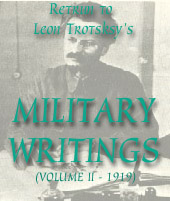
The deep breakthrough effected by Mamontov’s cavalry made it necessary to raise up local forces out of the land. It can be said that our Soviet apparatus has in this matter again shown sufficient flexibility and capacity for concentrated work at an urgent task: in many localities – railway junctions, uyezd towns, and to an even greater degree in provincial centres – groups and detachments, not only of infantry but also of cavalry, have been created literally ‘out of nothing’. Whereas in the first few days MaMontov’s raiders proceeded quite without hindrance, after their capture of Tambov they began to encounter resistance at every step.
It must be said, however, that this resistance does not yet display the required staunchness. The local Soviet homeguard, which arose in order to rebuff the raiders, is still far from fully up to Its task.
The detachments of the revolutionary committees are too much infected with ‘local’ spirit.
’Local’ limitedness is expressed above all in the fact that the commanders of these detachments do not try sufficiently hard to establish communications to their left and right and behind them, and have an extremely negligent attitude regarding their duty to report. This makes it extremely difficult to unify the forces and their leaderships. The commander of every detachment specially formed to combat Mamontov’s cavalry must look on his detachment not from the standpoint of defending his junction or his settlement but from that of the common task of surrounding and annihilating Mamontov’s cavalry. Each detachment is merely a link in a common chain. Therefore, first and foremost – liaison and proper, precise reporting.
Attachment to the locality also finds expression in lack of the required initiative. An uyezd detachment waits patiently for the White cavalry to descend upon its uyezd, so as to repulse it on the spot. This will not do at all. Local Soviet detachments must make it their business to prevent the enemy cavalry from pas sing through, to pursue it, take it unawares, and do it all kinds of harm. If the Soviet detachment is small it cannot, of course, engage in conflict with large enemy columns, but it is always capable of exterminating patrols; of attacking the enemy’s rear, his transports and stragglers; of taking prisoners; of driving off, capturing or killing, depending on circumstances, the enemy’s horses when they are resting, and so on and so forth. Where such separate enterprises are concerned, the Soviet detachments must, without waiting for orders from the centre, themselves display the initiative required.
A waiting attitude is inadmissible also because it lowers morale instead of hardening it. A freshly formed detachment that passively awaits an enemy raid at the borders of its own uyezd or in the approaches to its own town, will in most cases show itself to be of poor fighting capacity when it does actually meet the enemy cavalry. Prolonged inactive waiting for the enemy demoralises people, it engenders sluggishness and even an inclination to panic. As soon as a detachment is formed it must be given a task to perform. Until the detachment has been properly subordinated to the nearest sectoral command, this task must be assigned independently by the detachment commander. The first task should be in the sphere of reconnaissance: making contact with the enemy, taking a few prisoners, and soon. After its first successful raid the detachment will be transformed: it will at once feel an uprush of self-confidence, if only because it will have seen how frightened Mamontov’s troopers are, feeling as they do that they are completely surrounded by enemies.
We must overcome at all costs the immobility and sluggishness of the detachments of the Soviet homeguard. For this purpose the best, most militant of the local workers must join them. The best horses, the best motor-cars and means of transport generally must go to the Soviet detachments!
More self-confidence, less passive waiting and circumspection, more initiative, more examples of courage, resourcefulness and daring! Then the local Soviet homeguard will soon acquire the warlike character that it needs, and every detachment will become an inspired link in one common chain. With this chain we shall strangle Mamontov.
September 11, 1919
Tula
En Route, No.93

Last updated on: 22.12.2006